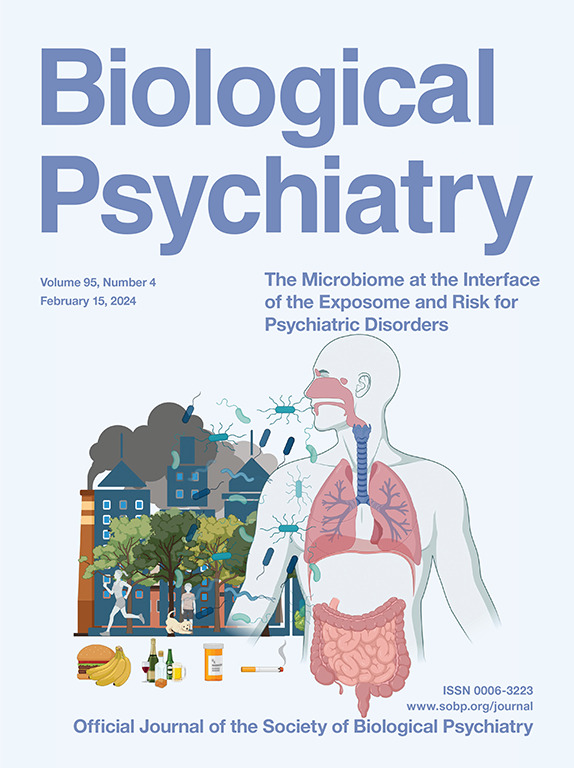重度抑郁障碍的区域结构-功能连接耦合与神经递质和遗传特征有关。
IF 9.6
1区 医学
Q1 NEUROSCIENCES
引用次数: 0
摘要
背景:在重度抑郁障碍(MDD)患者中发现了结构-功能连接(SC-FC)耦合异常。然而,这些研究忽视了这些异常在不同脑区的可变性和层次性分布。此外,区域 SC-FC 耦合模式的生物机制也不甚明了:我们招募了 182 名 MDD 患者和 157 名健康对照组(HC)受试者,量化了区域 SC-FC 耦合的组间差异。我们构建了极端梯度提升(XGBoost)、支持向量机(SVM)和随机森林(RF)模型,以评估SC-FC耦合作为MDD诊断和症状预测生物标志物的潜力。然后,我们研究了 MDD 患者区域 SC-FC 耦合变化、神经递质分布和基因表达之间的联系:结果:我们观察到,与 HC 相比,MDD 患者默认模式网络的区域 SC-FC 耦合增加(T = 3.233),而顶叶前网络的耦合降低(T = -3.471)。XGBoost(AUC = 0.853)、SVM(AUC = 0.832)和RF(p < 0.05)模型表现出良好的预测性能。MDD 患者区域 SC-FC 耦合的改变与四种神经递质的分布(p < 0.05)和特定基因的表达图谱相关。这些基因与兴奋性神经元、抑制性神经元、细胞代谢、突触功能和免疫信号转导有关。这些发现在两个脑图谱上得到了重复:这项研究加深了我们对 MDD 的了解,并为开发更多有针对性的治疗干预措施铺平了道路。本文章由计算机程序翻译,如有差异,请以英文原文为准。
Regional Structural-Functional Connectivity Coupling in Major Depressive Disorder Is Associated With Neurotransmitter and Genetic Profiles
Background
Abnormalities in structural-functional connectivity (SC-FC) coupling have been identified globally in patients with major depressive disorder (MDD). However, investigations have neglected the variability and hierarchical distribution of these abnormalities across different brain regions. Furthermore, the biological mechanisms that underlie regional SC-FC coupling patterns are not well understood.
Methods
We enrolled 182 patients with MDD and 157 healthy control participants and quantified the intergroup differences in regional SC-FC coupling. Extreme gradient boosting (XGBoost), support vector machine, and random forest models were constructed to assess the potential of SC-FC coupling as biomarkers for MDD diagnosis and symptom prediction. Then, we examined the link between changes in regional SC-FC coupling in patients with MDD, neurotransmitter distributions, and gene expression.
Results
We observed increased regional SC-FC coupling in the default mode network (t337 = 3.233) and decreased coupling in the frontoparietal network (t337 = −3.471) in patients with MDD compared with healthy control participants. XGBoost (area under the receiver operating characteristic curve = 0.853), support vector machine (area under the receiver operating characteristic curve = 0.832), and random forest (p < .05) models exhibited good prediction performance. The alterations in regional SC-FC coupling in patients with MDD were correlated with the distributions of 4 neurotransmitters (p < .05) and expression maps of specific genes. These enriched genes were implicated in excitatory neurons, inhibitory neurons, cellular metabolism, synapse function, and immune signaling. These findings were replicated on 2 brain atlases.
Conclusions
This work enhances our understanding of MDD and paves the way for the development of additional targeted therapeutic interventions.
求助全文
通过发布文献求助,成功后即可免费获取论文全文。
去求助
来源期刊

Biological Psychiatry
医学-精神病学
CiteScore
18.80
自引率
2.80%
发文量
1398
审稿时长
33 days
期刊介绍:
Biological Psychiatry is an official journal of the Society of Biological Psychiatry and was established in 1969. It is the first journal in the Biological Psychiatry family, which also includes Biological Psychiatry: Cognitive Neuroscience and Neuroimaging and Biological Psychiatry: Global Open Science. The Society's main goal is to promote excellence in scientific research and education in the fields related to the nature, causes, mechanisms, and treatments of disorders pertaining to thought, emotion, and behavior. To fulfill this mission, Biological Psychiatry publishes peer-reviewed, rapid-publication articles that present new findings from original basic, translational, and clinical mechanistic research, ultimately advancing our understanding of psychiatric disorders and their treatment. The journal also encourages the submission of reviews and commentaries on current research and topics of interest.
 求助内容:
求助内容: 应助结果提醒方式:
应助结果提醒方式:


